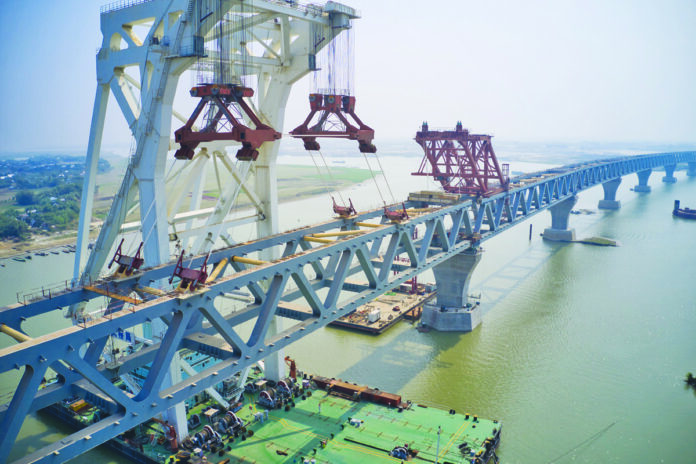When Chinese Premier Li Qiang embarked on a test ride aboard the Jakarta-Bandung High-Speed Railway, a monumental project within the realm of the Belt and Road Initiative (BRI), on September 7, it signified the inauguration of a fresh chapter in the ongoing BRI narrative.
This remarkable project, emblematic of the China-Indonesia Belt and Road partnership, stands as a groundbreaking feat. It represents the very first international high-speed railway project to wholeheartedly embrace China’s cutting-edge railway systems, technology, and industrial components.
Moreover, it also marks Indonesia’s inaugural foray into the realm of high-speed rail, an achievement that resonates throughout Southeast Asia. The Jakarta-Bandung High-Speed Railway project, one of hundreds of development initiatives spanning the entire Belt and Road Initiative route, stands as a beacon of connectivity and a testament to the transformative power of the Belt and Road Initiative launched by China in the autumn of 2013.
This endeavour encapsulates the spirit of international cooperation and infrastructural progress, illuminating the path forward for nations eager to embrace progress and prosperity. The Belt and Road Initiative (BRI) signaled a pivotal turning point in China’s global engagement, representing its emergence on the world stage. Over the past decade, it has undeniably reshaped the global landscape, affirming its profound impact on the world.
For five apparent reasons, the Belt and Road Initiative (BRI) has orchestrated a profound transformation on the world stage. Firstly, it has elevated the discourse on development to a paramount global concern. Secondly, it has fostered an unprecedented rapport between China and the developing nations. Thirdly, it has paved the path toward a fresh global alignment and, consequently, a novel paradigm of global politics. Fourthly, it has introduced core principles of Chinese philosophy to the global arena. Fifthly, it has birthed an entirely novel breed of international institution, offering a glimpse into a world order where the welfare of the majority takes precedence over the minority— an extraordinary reimagining of global dynamics. The Belt and Road Initiative (BRI) must be perceived as a dynamic entity, perpetually evolving in harmony with the evolving global landscape.
In its inception, the focal point was colossal infrastructure ventures. Yet, concurrently, the BRI has seen the ascension of small and medium-sized enterprises, environmental sustainability, climate considerations, digital innovation, and green initiatives. While the covid-19 pandemic precipitated a temporary slow down, the BRI has since rebounded with renewed vigour as the world returns to a semblance of normalcy. This resilience showcases the BRI’s adaptability to fluctuating global conditions. The BRI remains a resilient and responsive force, mirroring the ever-changing contours of the world it engages with.
Evidently, the global community is increasingly embracing the initiative, signifying a notable shift in global policy orientation. This transformation bodes well for global progress. The initial iteration of the BRI has served as a foundational platform. Beyond its original scope of collaboration with developing nations, it has spurred the emergence of the Global Development Initiative, Global Security Initiative, and Global Civilization Initiative.
Accusations against the BRI have been fanned by the US and its allies, with claims of it being a “debt trap,” a new form of colonialism, and environmentally harmful. Yet, the stance of participating nations disproves these allegations. Robust collaboration and a multitude of ongoing projects within the BRI framework demonstrate the mutual benefits derived from this partnership.
These progressive offshoots represent a deliberate evolution of the initial concept, offering diverse and robust approaches to bolstering global development and fortifying the achievements of the BRI. This multi-pronged strategy heralds a promising era for global advancement. Southeast Asia, recognized as a pivotal nexus for both maritime and land routes within the BRI, is poised to witness a surge in infrastructure expansion, particularly in rail connectivity. While conventional infrastructure development persists, the burgeoning role of digital connectivity is set to instigate substantial demand for digital infrastructure across the region. This digital frontier is expected to assume a central role in the forthcoming phase of BRI implementation. Simultaneously, the green and blue economies emerge as twin catalysts likely to dominate the China-ASEAN economic cooperation agenda. These multifaceted developments herald a promising trajectory for regional progress and collaboration.
In tandem with the burgeoning digital economy, prominently exemplified by e-commerce, the green economy stands out as a pivotal force in the ASEAN-China Free Trade Area 3.0 framework. Likewise, the blue economy’s prominence is underscored by the ASEAN Leaders’ Declaration on Blue Economy in 2021. These developments foreshadow a multifaceted evolution of China-ASEAN collaboration, encompassing enhanced human connectivity and cultural engagement. These strides align harmoniously with the objectives laid out in the ASEAN 2025 Vision.
The true essence of the BRI resides in its enduring legacy, particularly when it reaches its full fruition. Completion of this ambitious endeavour promises a wealth of knowledge exchange, idea dissemination, and the cultivation of innovative concepts. It is an extensive journey, not confined to a mere decade but rather a long-term commitment. As more nations become intertwined with the BRI, they recognize the multitude of developmental needs waiting to be addressed. Consequently, the BRI is akin to an everlasting, towering mountain, with each ascent revealing greater vistas, ideas, and awareness.
In the span of the past decade, China has embarked on an ambitious journey, collaborating with over 150 countries and 30 international organizations to co-build the BR). This monumental effort has seen the realization of more than 3,000 cooperation projects under the BRI banner, amounting to a substantial investment of nearly $1 trillion. The impact has been nothing short of transformative, sparking robust economic growth in partner nations.
These BRI projects span an array of crucial areas, from poverty alleviation to advancements in agricultural technology and vocational education. Notably, many of these endeavours have made significant strides in improving the quality of life for countless individuals. Furthermore, the ripple effects of these transportation-related BRI projects are poised to yield substantial global benefits. Projections indicate that by 2030, these projects alone will elevate global income by a remarkable 0.7-2.9 percent and, more importantly, lift a staggering 7.6 million people out of the grip of extreme poverty. These figures underscore the profound and positive impact of China’s commitment to international cooperation and development through the BRI.
In our interconnected world, possibilities for peace, progress, and prosperity multiply. Whether through physical infrastructure like roads, pathways, skyways, or bridges, the act of bringing people together enhances global security, well-being, and productivity. Personal acquaintance with diverse cultures, values, and objectives promotes a harmonious world where individuals work together for a common good. Awareness of others’ priorities alters perspectives and engenders supportive collaboration, fostering a better world that accommodates everyone’s aspirations.
Accusations against the BRI have been fanned by the US and its allies, with claims of it being a “debt trap,” a new form of colonialism, and environmentally harmful. Yet, the stance of participating nations disproves these allegations. Robust collaboration and a multitude of ongoing projects within the BRI framework demonstrate the mutual benefits derived from this partnership.























